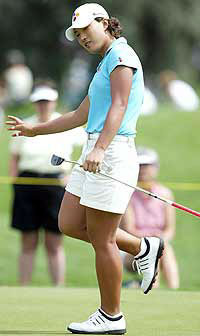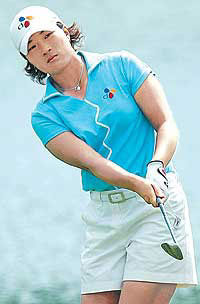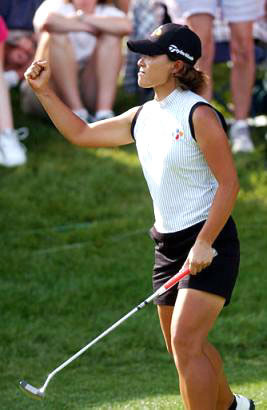 |
 |
 |
 |
 |
 |
First Term Report Cards
Remember those school days, when you had to dread that quarterly ritual of the 'report card'? Or perhaps you never dreaded it, cause you never had bad grades to worry about (brown noser!)? Or maybe you are still in school, and not as ancient as ye editor?
Well, regardless, the Seoul Sisters don't have to answer to anyone but themselves in the end. Oh sure, they have to keep sponsors, family and Korean media happy, but in the end, it is their decision as to how hard they work and to some extent what they accomplish.
But hey, if I have that attitude towards them, there would be no article, would there? So below, I'll give my educated opinion on how the top Korean players have been doing this year, based on past performance and current expectations. I'll give them each a grade, too. Note that each player is being judged only by their own particular standards, which makes it a bit harder for a player like Se Ri Pak to get an A than Hee-Won Han. But if you want to compare them with each other instead, just look at the money list! This is something else entirely!

Se Ri Pak

Se Ri Pak, the top player among the Koreans, always needs to be held to a slightly higher standard than the others. In 2002, she had a pretty darn great season. Unfortunately, she was blown away in the standings for all the post season awards, because Annika seemed well nigh unbeatable. If Se Ri were going to truly compete to be the very best (and nothing less would be a viable challenge for her in 2003), she would need to be consistent right from the start of the season. The biggest problem she has had the last few years is that her top opponent (be it Karrie Webb or Annika Sorenstam) always gets out to a fabulous start; then Se Ri spends the rest of the season trying to catch her. Even in 2002, with 17 top tens to her credit, she did not really bring her A Game consistently to the course until mid-August. From then til the end of the year, when she was healthy, she was able to go toe to toe with Annika. But unfortunately, by then the post season awards had already been all but decided in Sorenstam's favor.
In 2003, Se Ri dedicated herself even more strongly than before to strengthening and conditioning, while keeping up her normal intense six day a week work on her game. How have the results been?
Well, by this point in 2002, Se Ri had played in six events. She had no finish worse than 18th, and had a win and three other top tens. This year, Se Ri has played in 8 events, but missed the cut in the first one; every other finish, however, has been in the top 15, and she has five top tens, including two wins.
Throwing out the Tucson event where she missed the cut, which you could chalk up either to first event rustiness or a course that put a premium on putting, the one facet of her game that is sometimes balky, and the two season have both been fairly consistent: 7 top 15s this year vs. 6 top 20s in 2002. The percentage of top tens is also pretty similar: in 2002 Se Ri had top tens in 4 of her first 6 starts, while this year it's 5 in 8 starts. Obviously, having two wins this year vs. one last year puts her a little ahead in that department.
But there is one way in which 2003 is clearly ahead of 2002. In 2002, Se Ri just did not shoot a lot of low scores in her first 6 events. In fact, her lowest score in that span was a 66 at the Electrolux in Nashville. More tellingly, her average score over those six events was a rather pedestrian 70.80. This was because, in addition to not shooting a lot of low scores, she also had an inordinate number of scores near par or much worse. In 21 rounds shot during those 6 events, she broke par only 13 times, and only shot in the 60s 7 times. As a result, she did not contend very often. She was definitely in contention throughout the Office Depot, which she won, and contended briefly at the Nabisco, where she finished 9th. She also had a shot to win the Chick-Fil-A, but bad weather made that eventuality unlikely. In the other three events, even though she finished well, she was never really in the mix come Sunday.
What a difference a year makes! Looking at the 8 events Se Ri has played in 2003, we see a plethora of great rounds. Indeed, she has had two 65s and two 64s already this year, all better than her best score to this point last year. She has had only one truly bad round, her final round 77 at the Nabisco. In the 27 rounds she has played in 2003, she has shot under par 20 times, and in the 60s 13 times; that's nearly half of her rounds so far in the 60s.

And that does not even include her play in the MBC X-Canvas KLPGA event, which she also won this past weekend (where she shot two more rounds in the 60s, including a 65, and three more rounds under par). Whereas Se Ri was in contention in at most half her events in 2002, in 2003, she has been in the mix in six of eight. She won two of them, was only a few shots out of the lead going into the final round at the Nabisco, was tied for the lead with a few holes left at the Office Depot, was only a couple shots out of the lead at the turn on the final day of the Takefuji, and had a legitimate shot of coming back at the Michelob as well. And her scoring average for 2003? 69.62, more than a stroke better than this time last year.
Everything about Se Ri's game seems more solid this year except her driving, which has mysteriously become much more unreliable than in years past. This is certainly something she needs to deal with pronto. But perhaps the biggest statement showing her improvement: she is atop the money list, whereas last year she was already down by a mile to Sorenstam, and is the tour's only two time winner at this date.
It's true Se Ri has some work to do, but you can't help but be encouraged by her season so far. And this is usually the weakest time of the year for her; the mind reels at what could be in store when she hits her usual mid season stride.